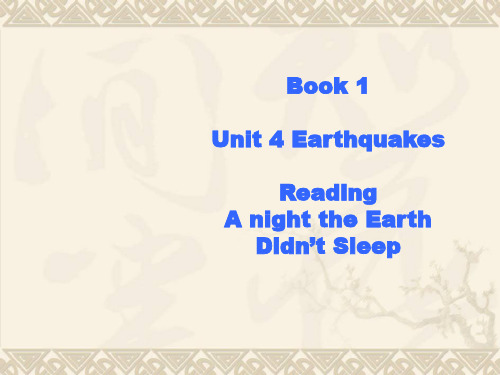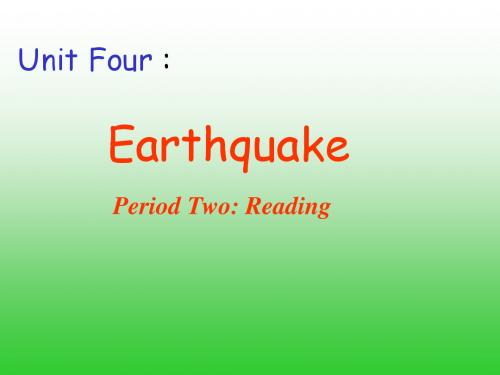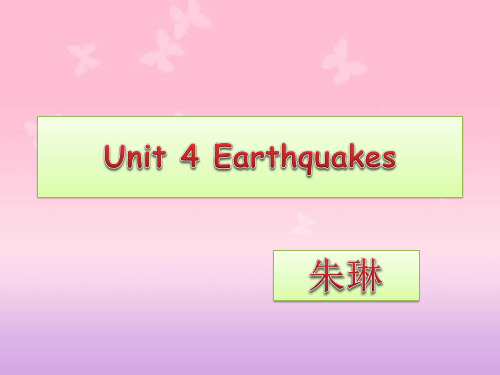Book 1 Unit4 Earthquake reading 2
- 格式:ppt
- 大小:545.50 KB
- 文档页数:20

课题:Book1 Unit4 Reading and ThinkingThe Night The Earthquake Didn’t Sleep 授课教师学校人与自然——语篇类型报告文学主题语境描述自然灾害课型阅读指导教师一、教学文本分析该文本标题为《地球不眠之夜》,是介绍1976年河北唐山大地震的纪实性报告文学。
该文本一共五个自然段,每个段落都有主题句。
按照时间顺序描述了该自然灾害发生的主线(明线),即地震前的预兆——地震中的破坏——地震后的救援与重建。
同时贯穿了地震中人们的情绪和情感变化(暗线):奇怪——震惊——绝望无助——抱有希望——乐观积极。
从文本叙述手法来看,本文运用多种修辞手法来组织语言增强了画面感,让读者身临其境般感受到灾难后唐山市满目苍夷、让人绝望的场面。
例如,标题The Night The Earth Didn’t Sleep 和“Slowly, the city began to breathe again.”运用了拟人的修饰手法;“It seemed as if the world were coming to an end!”运用了夸张的手法;“Bricks covered the ground like red autumn leaves”运用了比喻。
更值得一提的是,整个文本使用了很多数字,例如eleven kilometers, eight kilometers long and 30 meres wide, less than one minute, two thirds of the people, thousands of, more than 400,000等等不仅仅描述了地震带来的毁灭性的后果,又增加了该语篇的客观性、说服力和可信度,体现了报告文学真实性的特点。
为了体现主题意义,语篇末尾句“Tangshan city has proved to China and the rest of the world that in times of disaster, people must unify and show the wisdom to stay positive and rebuild for a bright future”启发学生思考唐山大地震中人民的团结和积极乐观面对灾难的向上精神是这座英雄的城市可以顺利重建的根本原因。



![Unit4 Earthquake-Reading[阅读课件]](https://img.taocdn.com/s1/m/8777ab6b25c52cc58bd6be09.png)

高中英语(人教版)必修一第四单元教案Unit 4 Earthquake一.教学内容分析本单元话题为"地震",主要描写了1976年唐山大地震,各项语言活动也都是围绕地震展开。
本单元共分八个部分。
Warming-up 部分通过两张图片引出话题"一旦地震发生,将会造成怎样的危害",为后面的主题作了一个热身运动。
Pre-reading 部分设置了两个开放性问题,目的是增加学生的生活常识,提高他们的应变能力。
这部分为接下来的阅读作了很好的铺垫,学生可通过套乱,参阅有关地震的书籍并运用一些生活常识来回答这两个问题。
Reading 部分具体描写了1976年唐山大地震的震前、震中和震后。
作者详细描述了地震来临前的一些不正常的自然现象及动物的反常表现;地震的来势汹汹并在顷刻间将整座城市夷为平地;震后人们勇敢面对现实并及时实施抢救和重建工作。
Comprehending 部分包括三组练习,主要目的是为了帮助学生更好地理解Reading部分的文章。
Learning about Language 部分分为两个部分:Discovering useful words and expressions 和Discovering useful structures.第一部分要求学生在把握文章的基础上,掌握重点词汇的词义及时用,这更注重培养学生运用上下文猜测词义的能力。
其次还对一些复杂的数字读法进行了检测。
第二部分则结合文章学习定语从句。
Using Language 部分分为Reading,Writing and Speaking;Listening和Writing。
Reading,Speaking 包括读一篇邀请函,写一份演讲稿和关于一套新唐山邮票的Little talk。
Listening 部分讲述了一位地震幸存者的故事,并根据听力材料进行正误判断和回答问题,旨在培养学生获取细节的能力,并通过听来模仿标准的语音和语调。
Unit 4 EarthquakesPart I a Night the Earth didn’t SleepStrange things were happening in the countryside of northeast Hebei.For three days the water in the village well s rose and fell, rose and fell. Farmers notice d that the well walls had deep crack s in them. A smelly gas came out of the cracks. In the farmyards, the chickens and even the pigs were too nervous to eat. Mice ran out of the field s looking for places to hide. Fish jumped out of their bowls and pond s. At about 3:00 am on July 28, 1976, some people saw bright light s in the sky. The sound of planes could be heard outside the city of Tangshan even when no planes were in the sky. In the city, the water pipe s in some buildings cracked and burst. but the one million people of the city, who thought little of these event s, were asleep as usual that night.At 3:42 am everything began to shake It seemed as if the world was at an end! Eleven kilometres directly below the city the greatest earthquake of the 20th century had begun. It was felt in Beijing, which is more than two hundred kilometres away. One-third of the nation felt it. A huge crack that was eight kilometers long and thirty metres wide cut across houses, roads and canal s. Steam burst from hole s in the ground. Hard hills of rock became rivers of dirt. In fifteen terrible second s a large city lay in ruin s. The suffer ing of the people was extreme. Two-thirds of them died or were injure d during the earthquake. Thousands of families were kill ed and many children were left without parents. The number of people who were killed or injured reach ed more than 400,000.But how could the survivor s believe it was natural? Everywhere they looked nearly everything was destroy ed. All of the city’s hospitals, 75%of its factories and buildings and 90% of its homes were gone. Bricks cover ed the ground like red autumn leaves. No wind, however, could blow them away. Two dams fell and most of the bridge s also fell or were not safe for travel ling. The railway track s were now useless pieces of steel. Tens of thousands of cows would never give milk again. Half a million pigs and millions of chickens were dead. Sand now fill ed the wells instead of water. People were shock ed. Then, later that afternoon, another big quake which was almost as strong as the first one shook Tangshan. Some of the rescue workers and doctors were trap ped under the ruins. More buildings fell down. Water, food, and electricity were hard to get. People began to wonder how long the disaster would last.All hope was not lost. Soon after the quakes, the army sent 150,000 soldier s to Tangshan to help the rescue workers. Hundreds of thousands of people were helped. The army organize d teams to dig out those who were trapped and to bury the dead. To the north of the city, most of the 10,000miner s were rescued from the coal mine s there. Workers built shelter s for survivor s whose homes had been destroyed. Fresh water was taken to the city by train, truck and plane. Slowly, the city began to breathe again.Part 2. Using languageDear____,Congratulations! are pleased to tell you that you have won the high school speaking competition about new Tangshan. Your speech was heard by a group of five judge s, all of whom agree d that it was the best one this year. Your parents and your school should be very proud of you!Next month the city will open a new park to honour those who died in the terrible disaster. The park will also honour those who helped the survivors. Our office would like to have you speak to the park visitors on July 28 at 11:00 am. As you know, this is the day the quake happened thirty-____years ago.We invite you to bring your family and friends on that special day.Sincerely,Zhang Sha。